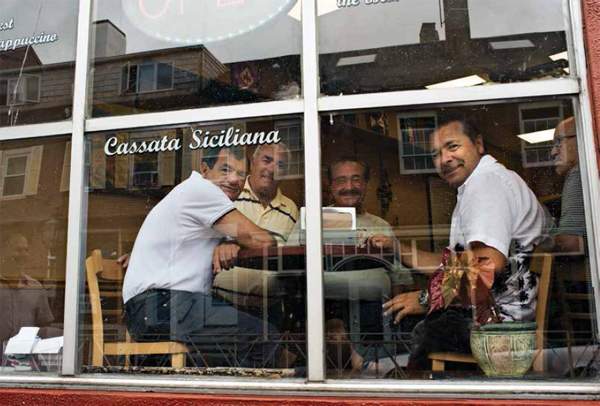

Cut to scene: Don Corleone looks into the eyes of his nervous godson, who is desperate for a coveted part in a Hollywood film. Drawing him close, the Godfather assures him that the movie mogul will do the right thing, saying in the cottony mumble that Marlon Brando made famous, “I’m going to make him an offer he can’t refuse.”
The easy imitation of this line from The Godfather—one of the most popular and parodied in movie history—has become part of the American vernacular, helping to usher in decades’ worth of assumptions and stereotypes about Italian Americans. (The line was probably borrowed from the French novelist Honoré de Balzac, and a variation appears in the work of Western culture’s first mythmaker, Homer’s Odyssey.) Most contemporary depictions are as crude as that of a portraitist dabbing a canvas with a housepainter’s brush: men—loud, dumb, violent; women—big hair, big mouth, make-ah the macaroni.
Myths about Italian-American culture run deep into the fabric of American life, obscuring the complicated, nuanced, centuries-long story of the Italian-American experience that demands to be told. One of the goals of this book—alongside telling this history—is to tease myth from reality and uncover a more complicated story and deeper truths.

Italian foodstuffs continue to link past and present for many Italian Americans.
Understandably, hyphenated Americans tend to romanticize the immigrant journey and present these tales through a lens of heroism in the face of hardship, leading ultimately to success. We create private myths that conform to universal ones. As the American mythologist Joseph Campbell famously patterned, the structure of myth has remained the same through the millennia: a hero with limited awareness has a “call to adventure,” confronts dangers and enemies along the way and, if he survives this road of trials, rededicates himself with renewed mastery and greater awareness.
In many ways this mythic journey foreshadows the story of all immigrants coming to America. We ask ourselves, How did our grandparents or great-grandparents or great-great-grandparents summon up the exceptional courage to cross the monumental ocean—that particularly American call to adventure—and settle in the New World? How did they muster the bravery to face the isolation of leaving family behind and to accept the dangers and hardships of brute labor and the insults cast by others who saw themselves as “more American”?
Heroes surely. But often a heroism born out of desperation.
The immigrants who made this journey also carried with them the scars of the past: centuries of poverty and subjugation that wreak havoc on and deeply scar the psyche. The tension, then, in trying to honestly recount and reconstruct history is to balance both concepts: the heroic journey to modernity and the damage left behind by a feudal and impoverished past.
Unlike other nineteenth-century immigrant groups, Italian Americans had several calls to adventure, crossing the perilous ocean more than once. Although they left Italy in unprecedented numbers, most had no intention of making the New World their permanent home. They saw themselves more as migrant workers than as immigrants, and they adopted a transnational life, coming to America to earn money and then returning to Italy, much as many Latinos today aspire to spend a few years in the United States in order to build the foundations for a more stable future in the country of their birth. Many Italians stayed longer than expected; some settled down forever. But over 50 percent of those who came to America went home.
The Italian Americans begins in the latter half of the nineteenth century, explaining why the immigrants left Italy and telling the stories of those who stayed in America. This book implicitly asks why so few Italian Americans know the full range of our history and responds to these potential gaps with a narrative that touches many regions of the country.
We may know about deeply rooted family bonds in the face of American individualism, about hardworking immigrants laying the foundation for a newly industrialized country, about Little Italies and tenement living, about a tenacious mayor named Fiorello La Guardia, the Hoboken crooner Frank Sinatra, the athletic grace of Joe DiMaggio, and the graceful articulations of Mario Cuomo.
But do we know about the plight of Italian Americans working on sugarcane plantations in Louisiana or those who were lynched in New Orleans? Or the story of a banker named Amadeo Giannini, who helped rebuild San Francisco after the great earthquake? Or a labor leader and poet named Arturo Giovannitti, who was arrested for trying to change terrible factory conditions in Massachusetts? Or do we know that when Joe DiMaggio was at the peak of his baseball career, the government branded his parents, hardworking citizens of San Francisco, “enemy aliens” because the United States was at war with Italy and the DiMaggios were not naturalized citizens? This designation prohibited the DiMaggios from entering Fisherman’s Wharf or visiting their son’s restaurant there.
Recent psychological research suggests that children who know their family history may experience a higher self-esteem and stronger sense of control because they are able to participate in a narrative larger than the individual self and nuclear family. It seems hardly a leap to imagine that adults, too, benefit from knowing their past. Family history helps fulfill an innately human desire to replace the more somber shades of the isolated self with a color-infused pattern of belonging. Perhaps readers, intrigued by the rich, multifaceted history of the ethnic group, will embark on their own particular quest of Italian and American identity and, like the hero of the journey, emerge with a fuller sense of self.
To better understand the ethos of Italian-American culture—its stubborn insistence on the primacy of family and bafflement of America’s ready embrace of individualism—is to trace the steps of a group of southern Italian men from Roseto Valfortore to the United States, who settled in Pennsylvania and built a community in the foothills of the Poconos that would replicate the one they had left behind. Leaving Italy in 1882, the men came to America desperate to escape the poverty of their mountain village in the region of Apulia, near the Adriatic coast.

There they labored as peasant farmers, traveling by foot for up to ten miles each day to reach land owned by the gentry. Some quarried marble from a neighboring town, and those lucky enough to have inherited a craft became stone carvers. The Rosetans lived in cramped two-story homes, the kitchen and stable on the first floor and bedroom above. Like their fellow countrymen throughout southern Italy, they heard about the promise of America.
The initial group of eleven men decided to make the journey after receiving encouraging letters from a Jesuit priest named Luigi Sabetti, who had grown up in Roseto Valfortore and emigrated to Baltimore. Eventually, eight of them, after a brief stay on Mulberry Street, found work in central Pennsylvania from a New York City employment agency. They summoned more people to join them, and each year their numbers multiplied. On a hillside they found a cheap and open tract of land empty of trees, which had been stripped for lumber. In 1887 these early residents named the town New Italy, eventually changing it to Roseto in memory of their village in the foothills of the Apennines. The ethnic enclave stayed true to its roots, speaking a regional Italian dialect and re-creating life from the Old Country.
The Rosetans had reasons to stick to their own: the Welsh, English, and Germans from the neighboring towns shunned the Italians. Slate quarries were the principal local industry, and the Anglo-Saxons, many of whom had learned this trade in the British Isles, owned the quarries and kept the best jobs for themselves. They gave the worst ones to the Italians—digging holes or throwing out rubbish—and paid them the pittance of eight cents an hour for a ten-hour workday, doled out only every three months.
So, for the ensuing decades, Roseto remained only for Rosetans, creating a safe harbor from what they perceived to be hostile outside forces. They built their own small church and eventually their own school. They built blouse mills in town where the women went to work. Two cousins ran bakeries from their home basements, producing bread loaves, pizza, and pasta for the entire town. (One of the bakeries—Le Donne’s—still exists today and uses the same bread oven from the 1930s.) Nearly everyone made their own wine and grew all of their own vegetables.
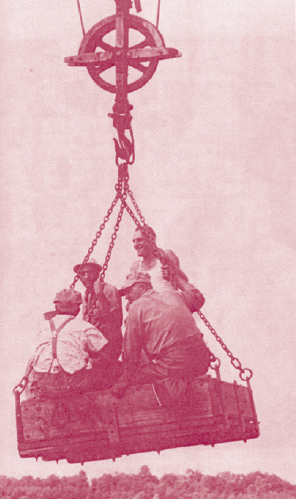
Slate quarries were the principal local industry in Roseto.
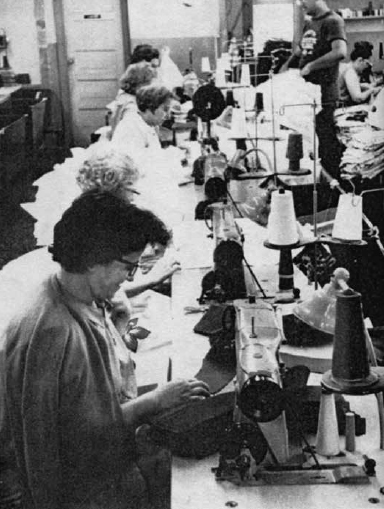
The Rosetans built blouse mills in town where the women went to work.
By the 1960s, more than seventy-five years after the arrival of its first immigrants, 95 percent of Roseto’s two thousand inhabitants were descendants of Roseto Valfortore, making it one of the most homogeneous ethnic enclaves in the nation. And at the time, Roseto received international attention as the home to a medical mystery—or perhaps medical miracle—one that would illustrate the protective effects of an emotionally supportive community in preventing heart disease.
The town had caught the attention of two doctors, Stewart Wolf and John Bruhn, after a resident cardiologist mentioned to Wolf, who owned a vacation home in the Poconos, that hardly anyone under fifty-five in Roseto had died of a heart attack or had signs of heart disease. For those over sixty-five, the rate of heart disease was about half that of the neighboring English, Welsh, and German towns and half the national average.
At the time, heart disease was the number one killer of Americans, and doctors were concerned that it was affecting men at increasingly younger ages. Wolf and Bruhn decided to study the health records of Rosetans, launching a multiyear effort that began in 1961. They discovered that although the residents indulged in salamis, cheeses, sausages, and cigarettes; although they abandoned their healthy native extra-virgin olive oil for artery-clogging lard; although they transformed traditional flatbread pizza with olive oil and salt into New World versions with sausage, pepperoni, salami, ham, and egg, the Rosetans weren’t dying of heart disease.
The curious doctors ruled out other possibilities. They didn’t believe that the reason for this phenomenon was genetic; the doctors studied relatives of the Rosetans in other parts of the country and found they weren’t as healthy. And it wasn’t environmental; the same water supply, doctors, and hospitals served Roseto and the neighboring towns. After years of study, Wolf and Bruhn concluded that the town’s communally supportive behavior—later dubbed the “Roseto Effect”—made all the difference.
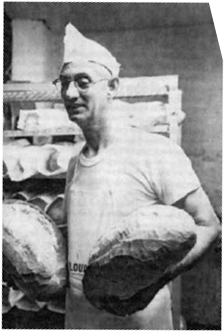
Two cousins ran bakeries from their home basements.
Rosetans chose to live a family- and community-centered egalitarian life. Those who had prospered didn’t flaunt their wealth and lent support to the less fortunate, residents almost exclusively patronized local businesses, and they predominantly intermarried. Doctors couldn’t tell wealthy from poor Rosetans because everyone dressed alike and lived in modest homes.
Southern Italian culture and peasant mysticism reinforced the Rosetans’ actions and template for living. Southern Italians—from illiterate peasants to cultured Neapolitans—believed deeply that other people, especially through the power of their stare, had the ability to bring grave harm to them and their families through what they called malocchio, the “evil eye.” The homogeneity and isolation of the community kept practices like warding off the evil eye common ones, passed through the generations. Rosetans conjured up potions with water, olive oil, and iron tools or wore amulets (a horn around one’s neck was typically considered the best protection), and they would never flaunt wealth—God forbid!—lest pride invite malocchio upon them. As one Rosetan told Carla Bianco, an Italian anthropologist studying the town during the same period as the two doctors, “The people think you’re rich and they envy you. So you catch the evil eye. Envy is powerful. We say, ‘If envy were fever, the whole world would be in bed.’”
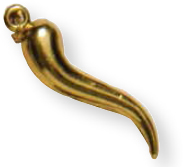
Southern Italian men typically wore the gold horn (cornetto) on a neck chain to protect against the evil eye.
In 1963, two years after the initial study, Wolf and Bruhn predicted that if this Old World culture began to crumble—as the times and the steady infiltration of American values suggested it would—so, too, would the protective benefits against heart disease. Their hunch was correct: younger Rosetans of that era, the first generation to become college educated, believed the town lacked opportunity, and many didn’t return after graduation. Gradually, malocchio began to lose its powerful grip on the psyche, and with this demise, in crept envy: people wanted bigger homes and fancy Cadillacs. Twenty years later, when the same doctors conducted a follow-up study in 1985, they noted that competition outpaced cooperation, and the mortality of the Rosetans was the same as that of everyone else.
The story of Roseto challenges some ingrained notions about the primacy of individualism and offers a cautionary tale about the stress-related perils of materialism. The doctors were ahead of their time observing in the 1960s that communities matter—that socially supportive environments can protect against heart disease, while isolation and loneliness are risk factors for it. The idea of a mind-body connection in understanding and treating illness wouldn’t gain traction for another few decades. Today, health researchers have returned to Roseto to analyze the merits of investigating disease by observing community behavior.
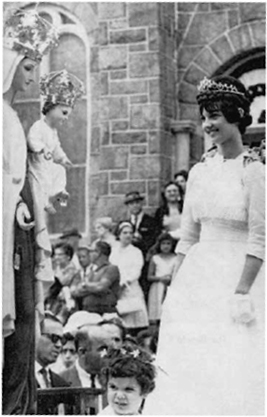
Every July, Rosetans would crown a young woman at the Celebration of Our Lady of Mount Carmel.
Similarly, more and more contemporary Americans, feeling alienated from a sterile, fast-paced, and flavorless twenty-first-century life, are also practicing some aspects of Old World ways: cultivating gardens, buying local, and even making their own wine. The Rosetans, the doctors reported, grew their own lettuce, green peppers, onions, peas, beans, endive, eggplant, tomatoes, corn, beets, cucumbers, figs, peaches, peas, apples, pumpkins, cherries, plums, parsley, oregano, basil, mallow, and other herbs—a cornucopia mirrored today at the varied stalls of local farmers markets.
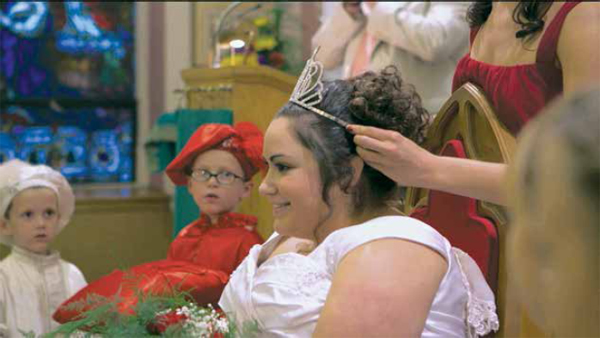
The tradition continues today.
Italians toast one another with the words Cent’ anni!—“May you live one hundred years!” Life in Roseto once seemed to offer the potential for that promise. A one-hundred-year look at Roseto, Pennsylvania—from the time the immigrants first arrived in 1882 until the 1985 follow-up study by Wolf and Bruhn—poses some important questions about the way we live today.
Could Old World communities like Roseto offer a countercheck to an increasingly alienated society? What’s lost and what’s gained, who benefits and who is harmed, by leaving the Old World clan for New World independence? If the ideology of contemporary American life is one of individualism, competitiveness, and materialism—and we know that these traits invite bad health and unhappiness—can we find the means within ourselves to change course, to choose a path of cooperation and egalitarianism over competition and inequality?
Well into the new millennium, Americans have an uneasy sense that not all of modernity is healthy or pleasing to the senses, while also knowing they would not replicate a life forged in part by Old World superstitions or one that shuns geographic mobility. One inclination would be to meld elements of the Old World with the New, but to accomplish this delicate feat without being trapped by the distorting effects of nostalgia, Italian Americans—and all other Americans—might want to explore this rich and varied past.
Un’ altra cent’ anni! To another one hundred years!

 Adriana Trigiani is the New York Times best-selling author of fifteen books that have been translated into over thirty-five languages. Her experiences growing up in Roseto, Pennsylvania, influenced her novel The Queen of the Big Time, based on the town’s annual celebration of its patron saint, Our Lady of Mount Carmel—or “the Big Time,” as the occasion is called by the young women who compete to be the pageant’s queen. Trigiani’s family moved from Roseto to Big Stone Gap, Virginia, the setting and title of her debut novel, which was followed by three sequels.
Adriana Trigiani is the New York Times best-selling author of fifteen books that have been translated into over thirty-five languages. Her experiences growing up in Roseto, Pennsylvania, influenced her novel The Queen of the Big Time, based on the town’s annual celebration of its patron saint, Our Lady of Mount Carmel—or “the Big Time,” as the occasion is called by the young women who compete to be the pageant’s queen. Trigiani’s family moved from Roseto to Big Stone Gap, Virginia, the setting and title of her debut novel, which was followed by three sequels.
Q: What was life in Roseto like when you were growing up?
Trigiani: Some of my most incredible childhood memories are from Roseto, Pennsylvania. Everything centered around the church, the Mass, the pageantry of the Mass, which I always found incredibly profound. If you go into Our Lady of Mount Carmel Church, there’s a golden light in there, and I’d imagine that was what heaven would be like. Then you’d walk down the street, and you’d go to Cousin Ralph’s, and they’d have cocktails after Mass or a drink. Then there would be dinner, and we’d go down to my Great-Aunt Mary’s. It was fantastic because the pasta was homemade and the sauce was homemade. We’d spend hours in the basement rolling pasta.
Q: How was Roseto, Pennsylvania, similar to Roseto Valfortore in Italy?
Trigiani: It’s crazy; when you go to Roseto Valfortore and then you come to Roseto, Pennsylvania, they’re mirror images of each other. The double porches were part of two-family homes. They had those porches in Italy, so they built them in Roseto. The first group that came here went to work in the slate quarries. Basically, the folks hiring the Italians ghettoized them and gave them this hill. When you go up that hill, you think you’re going to see an ocean on the other side. You’re in Pennsylvania. There’s no ocean, but when you go up that hill, it feels like it does when you’re in Italy and see the ocean. They may have tried to give us the worst piece of land, but it ended up being just as beautiful as in Italy.
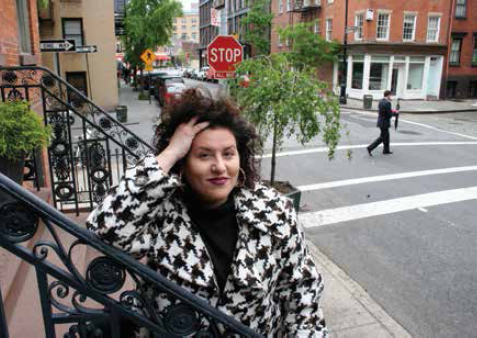
Q: Doctors have been studying Roseto for decades because of its once low rate of heart disease. Do you think there are lessons to be learned from Roseto?
Trigiani: It’s very interesting to me, living in our times, when we’re struggling with how to take care of people. The best thing we can do for one another is provide work. In Roseto, they came up with an incredible idea, which was to put the women to work during the school hours of the day. You walked your kid to school, then you went to the factory, and you worked until three o’clock, when you would pick up your child and go home. You had every generation of the family living in the home, so you never had a babysitter. If you study Roseto, you see that the factories are right next door to the houses. There wasn’t a commute. You didn’t need a second car. The men went off to work in the slate quarries, or they were farmers, or they had factory jobs themselves. We so often hear that women’s working or being ambitious imperils home life, but it just wasn’t true. Roseto is the perfect model to show you that there is a better way to live, where everybody benefits when everybody works.
Q: How do you think the cultural values of Roseto helped protect people from stress?
Trigiani: The Italian way of life offsets stress because in Italy, and you can still see this today, it’s very intergenerational, interdependent. People didn’t just move away. They stayed pretty much within a town. You, hopefully, fell in love with somebody local, and you built a family, and then your parents babysat, and they were there. The Italian way of life is so simple. It’s take care of your own, keep your nose clean, enjoy the table, enjoy the gathering of your family. Make it as beautiful as you can with what you have. Invite the neighbor in. Keep your heart at ease. And work, work, work.
Q: Can you describe how the women in your family shopped and cooked?
Trigiani: You shopped local. It was grown local, but here’s the thing that always got me about Roseto—there was never a want. If somebody canned peppers, they brought you a couple quarts. Also, nothing was ever wasted. Everything in the hands of these women became a delicacy. When we would come in from mowing the lawn or doing some chores for my grandmother, she would take dandelion greens that she had picked, toss them in olive oil, then poach eggs in her gravy, in the red sauce, and ladle those eggs, fresh eggs, over the greens, and serve it with bread. You will never eat anything more delicious. Think about that meal. Does that meal even cost fifteen cents? You’ve got the dandelions in your yard. You’ve got the eggs and the gravy, and everybody ate well. They took nothing and made something out of it. That’s very, very Italian to me.
Q: Why did your family move from Roseto?
Trigiani: My dad was working for his parents at their mill in the mid-1960s. Garment manufacturing was a big business in the North, profitable and community based. My dad used to say that anyone could throw up ten sewing machines back then and make a living. Around 1966, the federal Small Business Administration did a big push to find young entrepreneurs in the North to go south to open garment factories. This was a key element of the War on Poverty programs; the idea was to bring industry to the South, using the successful model from communities like Roseto and other places in the North to provide jobs for the people who needed them most. The government wanted to model the success of these factories in a poverty-stricken place called Appalachia (which was defined as a landmass that stretched from southwestern Virginia all the way down to Georgia). The government representatives told my dad he could put up a factory anywhere he chose in the Appalachian region. Dad said the rate was so low, it was irresistible. He was thirty-three years old and ready to be his own boss.
Q: How did your grandmother take the move?
Trigiani: My grandmother Viola—my father’s mother—visited us in Big Stone Gap soon after we moved down south. I asked her if she liked it, and she said, “I could never live in a place where they don’t make cheese.”